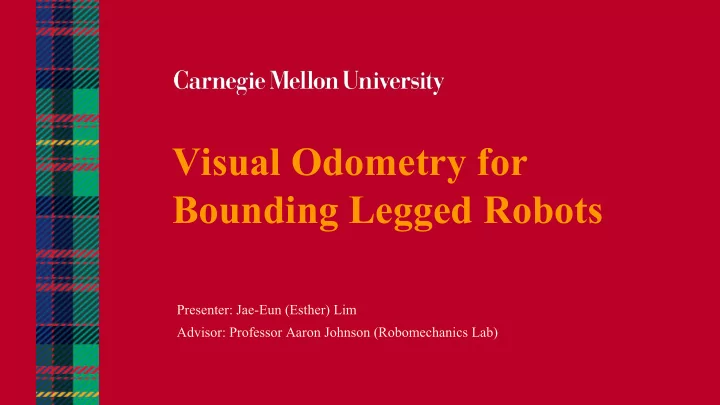

Visual Odometry for Bounding Legged Robots Presenter: Jae-Eun (Esther) Lim Advisor: Professor Aaron Johnson (Robomechanics Lab)
Background ● Visual odometry - estimation of position and orientation of a robot based on camera images ● Challenging task due to noises ● Use filter to combine with inertial information ● Extra challenge for bounding robot
Hypothesis The error in visual odometry estimation of a bounding legged robot is primarily caused by the pitch motion being confused as vertical displacement in the z-axis (vertical axis).
MATLAB Simulation
Assumptions ● Speed is known ● Perfect match of point pairs in two consecutive images ● Good lighting condition ● High resolution
Effect of Resolution 500x500 ● No pitch ● 50 inch straight in x-direction ● 40 inch/sec velocity 1000x1000 ● Estimation ● Actual 5000x5000
No Pitch No pitch 50 inch straight in x- direction 40 inch/sec velocity
Pitch 2° pitch angle 50 inch straight in x- direction 40 inch/sec velocity
Pitch 5° pitch angle 50 inch straight in x- direction 40 inch/sec velocity
Pitch Frequency ● 2~20 degree pitch angles ● 50 inch straight in x-direction ● 40 inch/sec velocity
Conclusions ● For a bounding legged robot, visual odometry estimation makes error in z-displacement ○ Pitch motion is confused as vertical displacement ● Increasing pitch frequency causes directional confusion and increases error
Future ● Introduce noises such as point pair mismatch, inaccurate inertial data, etc. ● Include turns in the robot’s path ● Motivate others to do research in improving the accuracy of visual odometry estimation for legged robots
Thank You
Recommend
More recommend